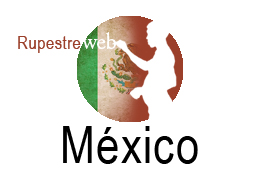
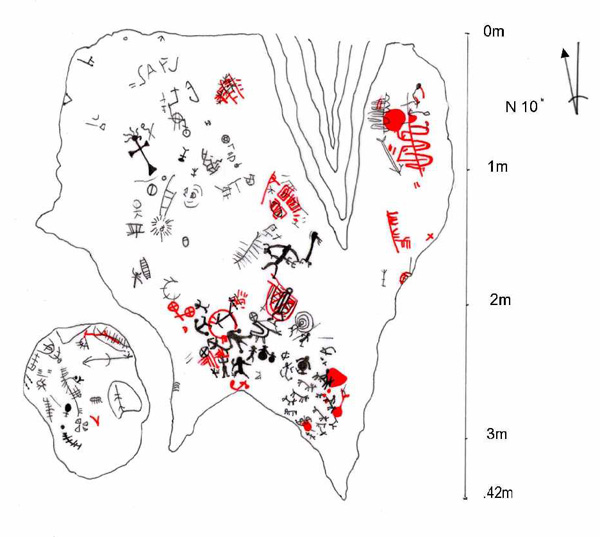 |
|---|
Figura 1 All Designs, site GPES. |
The presence of archaeological remains in the canyon and vicinity has been known for some time by the landowners in Guadalupe Canyon. The first archaeological record was a surface survey of the canyon mouth in 1967 by Joseph S. Fontaine, (Fontaine 1967). He recorded pictographs and petroglyphs, camps, pottery shard concentrations and deep bedrock mortars.
The next archaeological record was made in 1992 by Mexican archaeologist Jorge Serrano (1992). He recorded several petroglyphs and pictographs again in the mouth of the Canyon. Between 1997 and 2000, the Mexican archaeologist Cesar Berkovich, (Berkovich 2001) made a new record of a site originally recorded by Serrano and designated the area as an officially protected archaeological area.
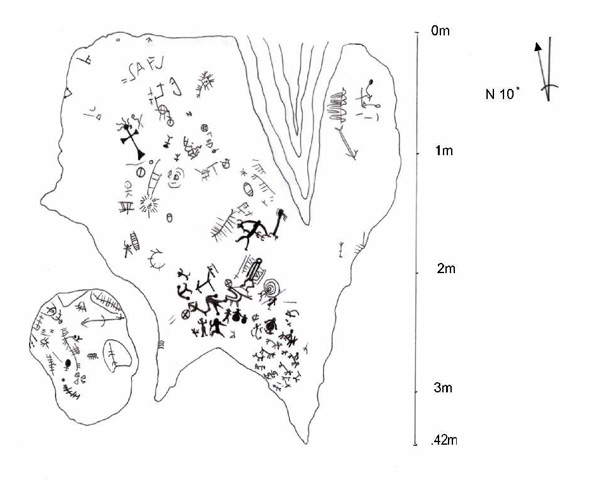 |
|---|
| Figura 2 All Designs, site GPES.
Centro Inah Baja California. PRRSABJ-FMM Cañon de Guadalupe-GPES -001. Responsable: Arqlgo Antonio Porcayo Michelini. Dibujo: Angelita Ortega Mancillas.vFecha del dibujo: 10/01/07. |
Mexican archaeologist Antonio Porcayo knew of the existence of this site since 2004, but the pictographs were not recorded until January 2007. In the project “Registro y rescate de sitios arqueológicos de Baja California Fase Municpio de Mexicali”, (Porcayo 2006]), an archaeological survey was made of the canyon and mouth. Drawings by a professional artist were made of the pictographs in GPE5 (see Figures 1-3) and of petroglyphs in a site near the mouth known as GPE1A (see Figure 4). Much archaeological material was found including pottery, lithics and a complete old and beautiful olla. The study of this material together with the paintings and petroglyphs will provide much information about the prehistoric inhabitants, their history and conflicts.
The archaeological site and its paintings
A large granite boulder perched on other boulders forms the rock shelter. The bottom side of the large boulder forms the ceiling of the rock shelter, about 1-1.5m above the ground. In two places the reddish outside of the boulder has eroded exposing lighter rock. It is in these eroded patches that the painting is found. One patch is smaller, roughly circular and about 1.5 m in diameter. The other is larger, irregularly shaped, and about 4 m in largest dimension. The erosion occurs in layers and in some places fragments of older ceiling layers persist.
The painting consists of red painted, black painted, and black scratched pictographs. The red pigment is most likely hematite, the black pigment manganese dioxide, and the black scratching was done with a piece of charcoal. In some places the scratched charcoal may have been rubbed into the rock by hand, but this is hard to distinguish from faded black paint. All three paintings types can be found in both painted areas of the rock shelter.
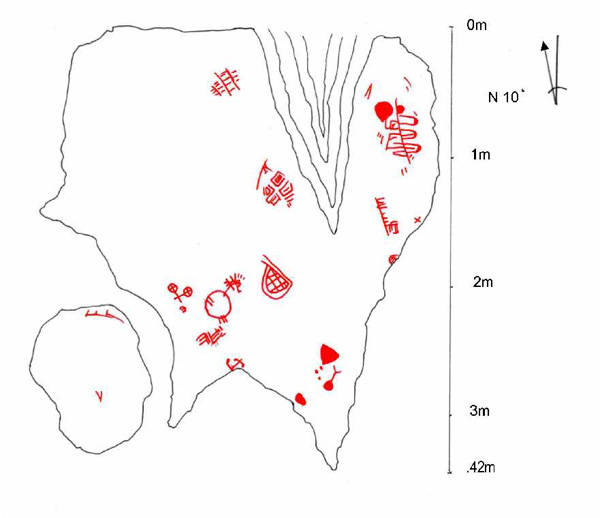 |
|---|
| Figura 3 All Designs, site GPES.
Centro Inah Baja California. PRRSABJ-FMM Cañon de Guadalupe-GPES. Responsable: Arqlgo Antonio Porcayo Michelini. Dibujo: Angelita Ortega Mancillas. Fecha del dibujo: 10/01/07. |
Scratched black figures are found in all areas of the rock shelter. These figures are always abstract, except for a Spanish Cross. Most scratched drawing consists of single thin lines scratched with charcoal. The cross was made with more care and is thicker. Many black scratched figures are found on top of black painted and red painted figures. In some cases they trace over and follow the painted figure beneath, in other cases they ignore the painting beneath. In the area near the cross there is a concentration of black scratched designs.
Black painting exists in both painted areas of the rock shelter. The black painted designs are always on top of the red painting, with one exception noted below. The black painting in the small patch is faded and consists of both abstract and stick figures. In the large patch the distribution of black painted figures is concentrated in one area, size about 1.5m x 1.5m that contains many bright black painted figures as well as a few fainter ones. The brighter figures consist mostly of human and animal figures. Some of the human figures have pear shaped bodies and some have headdresses. This may depict pregnancy or native dress. One human figure seems to be riding a horse, but this could be a juxtaposition of a human and mountain lion. Another is holding a snake or crook. Many animal figures, shown in profile, are quadrupeds with tails, possibly indicating coyotes or mountain lions. Other quadrupeds are shown from the front or back, have four legs and a tail, but no head. An intriguing possibility is that many of the black painted figures represent depictions of people in European dress. The pear shaped bodies could be women in dresses, the headdresses could be hats, the quadrupeds could be dogs or cattle.
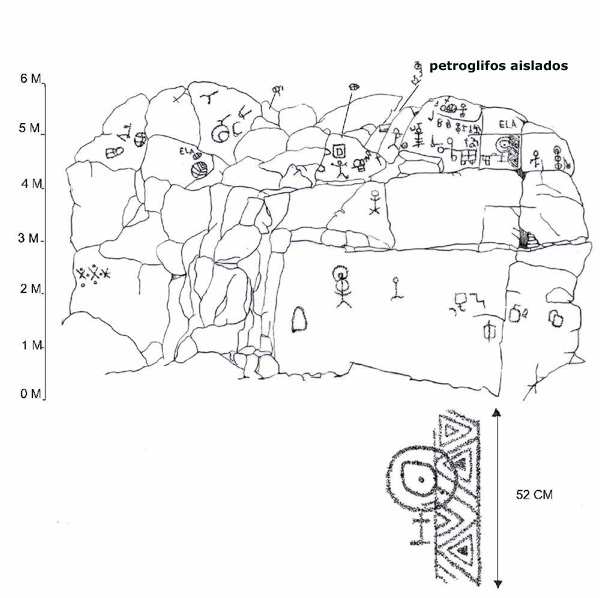 |
|---|
| Figura 4 All Designs, site GPES.
Centro Inah Baja California. PRRSABJ-FMM Cañon de Guadalupe-GPES -001. Responsable: Arqlgo Antonio Porcayo Michelini. Dibujo: Angelita Ortega Mancillas. Fecha del dibujo: 11/01/07. |
The red painting is for the most part very faded. It consists of large abstract and geometric designs and is found beneath the other painting. The faded nature of the designs makes details nearly invisible. The program DStretch was used to enhance digital images to bring out details. There are a few red paintings that are not faded. In the small patch there is a larger very faded abstract design, but also a small much brighter design consisting of two strokes. In the large patch most of the red designs are again large abstract and faded. However there also occur two small designs that are brighter. One of these designs is a human figure. It is the only representational red design in the cave and the only red design not overlaid by black.
Some comments
Without DStretch enhancement it is difficult to discern a style for the faded red paintings. Many of the paintings are too faint to follow the designs. After enhancement the abstract nature of the red figures is clear. It becomes possible to compare the style of the red paintings with the other rock art in Guadalupe Canyon.
Study of the painting indicates at least three identifiable painting episodes, each with a distinct style. Judging by superposition and content the scratched black painting is most recent and may not have been made by indigenous people. The painted black is next in age and the faded red painting is the most ancient. The evidence of two or more styles at GPE5 is not unique in Guadalupe Canyon. At the petroglyph site GPE1A near the mouth of the canyon two styles are also present.
At that site there is a rock face containing a vertical geometric design consisting of concentric triangles. The antiquity of this design is clear from the repatination of the grooves by desert varnish. Superimposed on the older design are much brighter concentric circles. To the left of this are more petroglyphs displaying a similar new over old pattern. There are intriguing similarities between the petroglyph motifs at GPE1A and the red designs in GPE5. In both cases the designs are abstract. In GPE5 there are very faint remnants of a design similar to the older geometric pattern. Other designs seem similar to the newer petroglyphs. The black painted designs at GPE5 have no similarities with the petroglyphs.
In site GPE3, also known as La Cueva, are petroglyphs with square designs similar to some red designs at GPE5. At GPE3 there is no superposition of elements, all petroglyphs seem of the more recent type. Near GPE3 during the project (Porcayo 2006) was found a complete olla in a small rock shelter. It is not known if the olla is the same age as the nearby petroglyphs.
In Palmas de Cantú Canyon, 20 km to the north, is a rock covered by petroglyphs all using nearly the same circular abstract motif. Again the dark desert varnish covering them indicates that these petroglyphs are old. Superimposed on this are newer brighter designs in a different style. The newer style seems similar to red designs in GPE5.
Attempting to relate different sites in Guadalupe Canyon based on style is certainly problematic. A review of the red paintings in GPE5 reveals a mix of elements, difficult to characterize as a single consistent style. However we feel it is worthwhile to attempt comparison of different sites even though it must be considered preliminary.
Both the pictographs at GPE5 and the petroglyphs elsewhere in Guadalupe Canyon record use by different peoples at the same sites at different times. There are many rock faces and rock shelters in Guadalupe Canyon, but only a few that contain rock art. Why did the ancient indigenous people use the same space to made newer petroglyphs or pictographs with different motifs over older ones? The example of Palmas de Cantú Canyon shows that this practice was not limited to Guadalupe Canyon. Several possible answers come to mind. The rock art may indicate struggles for dominance between different peoples. For example it may indicate warfare where the sacred areas or territorial marks of the vanquished were destroyed by the victors. A less belligerent possibility is that different groups were forced to share canyons containing scarce water resources. The superposition may reflect different occupations by peoples separated in time but utilizing (and recognizing as useful) similar landscape features.
There is an intriguing possibility of correspondence between pictograph and petroglyph traditions in Guadalupe Canyon, but much work remains to be done to establish this. It will be important to make detailed recordings of the paintings in the canyon and for such recording DStretch image enhancement has proved to be very useful.
![]()
—¿Preguntas, comentarios? escriba a: rupestreweb@yahoogroups.com—
Cómo citar este artículo:
Porcayo Michelini, Antonio y Harman, Jon. A pictograph rock shelter in Guadalupe Canyon,
Baja California, Mexico. En Rupestreweb, http://www.rupestreweb.info/guadalupecanyon.html
2014
REFERENCES
Berkovich, Cesar. 2001. Programa INAH – PROCEDE. Informe del Programa INAH Procede en Baja California del Año de 1997 al 2000. Centro INAH Baja California.
Fontaine, Joseph. S 1967. A Preliminary Report of Two Palm Canyon Along the Laguna Salada. Pacific Coast Archaeological Society Quarterly 3(1).
Porcayo Michelini, Antonio. 2006. Proyecto Registro y Rescate de Sitios Arqueológicos de Baja California - Fase Municipio de Mexicali. Centro INAH Baja California.
Serrano, Jorge 1992. Cañón de Guadalupe. Cédula de la Dirección de Registro Público de Monumentos y Zonas Arqueológicos del INAH.
